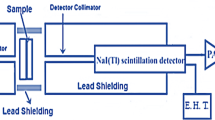Abstract
The glass-forming region in the PbO–GeO2 system is studied. To increase the glass-forming limit in this system, the tempering rate of the samples has to be increased using special methodological practices. The dependence of the temperature of the synthesis of lead germanate glass on the PbO content is obtained. It is shown that the corrosion of alumina crucibles proceeded during the synthesis of lead germanate glass. The dependence of the thickness of the corroded layer of the alumina crucible wall on the time of the synthesis of the glass of the 55PbO · 45GeO2 composition, mol % at 900°С is obtained. It is proved that the obtained glass is X-ray amorphous within the whole range of compositions in the PbO–GeO2 system.







Similar content being viewed by others
REFERENCES
Valenkov, N.N. and Porai-Koshits, E.A., About chemical compounds in the PbO–SiO2 system in the crystalline state, Zh. Fiz. Khim., 1935, vol. 6, no. 6, pp. 757–761.
Babcock, C.L., Silicate Glass Technology Methods, New York: Wiley, 1977.
Lezal, D., Pedlikova, J., and Horak, J., GeO2–PbO glassy system for infrared fibers for delivery of Er: YAG laser energy, J. Non-Cryst. Solids, 1996, vol. 196, pp. 178–182.
Topping, J.A., Harrower, I.T., and Murthy, M.K., Properties and structure of glasses in the system PbO–GeO2, J. Am. Ceram. Soc., 1974, vol. 57, no. 5, pp. 209–212.
Ivanov, A.O. and Evstrop’ev, K.S., On the structure of the simplest germanate glasses, Dokl. Akad. Nauk SSSR, 1962, vol. 145, no. 4, pp. 797–800.
Murthy, M.K. and Kirby, E.M., Infra-red spectra of alkali-germanate glasses, Phys. Chem. Glasses, 1964, vol. 5, no. 5, pp. 144–146.
Morozov, V.N. and Sharonova, N.N., Oscillatory spectra and the structure of lead germanate glasses, Opt. Spektrosk., 1969, vol. 26, no. 3, pp. 467–469.
Kolesova, V.A., Investigation of the structure of PbO–SO3–GeO2 system glasses by IR absorption spectra, Fiz. Khim. Stekla, 1980, vol. 6, no. 2, pp. 247–249.
Oyamada, R. and Hagiwara, H., Raman spectra of glassy PbO–GeO2 and PbO–B2O3 system, J. Ceram. Soc. Jpn. (Yogyo-Kyokai-Shi), 1978, vol. 86, nos. 992/4, pp. 151–158.
Canale, J.E., Condrate, R.A., Nassau, K., and Cornilsen, B.C., Characterization of various glasses in the binary PbO–GeO2 and Bi2O3–GeO2 systems, J. Can. Ceram. Soc., 1986, vol. 55, pp. 50–56.
Ribeiro, S.J.L., Dexpert-Ghys, J., Piriou, B., and Mastelaro, V.R., Structural studies in lead germanate glasses: EXAFS and vibrational spectroscopy, J. Non-Cryst. Solids, 1993, vol. 159, no. 3, pp. 213–221.
Denisov, V.M., Irtyugo, L.A., Istomin, S.A., Denisova, L.T., Shubin, A.A., and Pastukhov, E.A., The study of certain properties of liquid and solid GeO2–PbO system, Rasplavy, 2010, no. 4, pp. 3–10.
Kabanov, O.V., Podol’skaya, T.M., and Yanush, O.V., Raman spectra and structure of the PbO–SiO2 glasses, Glass Phys. Chem., 1996, vol. 22, no. 1, pp. 19–26.
Faraday, M., The Bakerian Lecture. On the manufacture of glass for optical purposes, Philos. Trans. R. Soc. London, 1830, vol. 120, pt. 1, pp. 1–57.
Gifford, J.W., The existing limits of uniformity in producing optical glass, Proc. R. Soc. London, Ser. A, 1912, vo. 87, no. 594, pp. 189–193.
Zschokke, W., Homogenitat des optischen Glases, Zeitschr. Instrumentenk., 1909, vol. 29, no. 9, pp. 286–289.
Shvetsov, B.S., About flaking glass when it hardens, Izv. Akad. Nauk SSSR, Ser. 7: Otd. Mat. Estestv. Nauk, 1931, no. 8, pp. 1141–1150.
Voitova, V.M., Kulikova, O.V., Lotarev, S.V., Sigaev, V.N., Koltashev, V.V., and Plotnichenko, V.G., Study of glass-forming systems PbO–GeO2 and PbO– B2O3 using Raman spectroscopy, Usp. Khim. Khim. Tekhnol., 2007, vol. 21, no. 7, pp. 47–51.
El’berg, M.S., Phase relations in metastable states of the PbO–GeO2 system, Cand. Sci. (Chem.) Dissertation, Krasnoyarsk, 2013.
Piryutko, M.M., Benediktova, N.V., and Korsak, L.F., An improved method for the determination of silicon in the form of a quinoline–silica–molybdenum complex, Steklo Keram., 1981, no. 8, pp. 30–31.
Schwarzenbach, G. and Flaschka, H., Die komplexometrische Titration, Stuttgart: F. Enke, 1965.
Vasilevskaya, T.N., Golubkov, V.V., and Porai-Koshits, E.A., On the structure of glasses of the B2O3– GeO2 system according to the data of the RMU, Fiz. Khim. Stekla, 1981, vol. 7, no. 1, pp. 31–37.
Ushakov, V.M., Viscosity of glasses of the PbO–GeO2 system, Report at the Laboratory Seminar of the Laboratory of the Structure and Properties of Glass, Oct. 24, 1989.
Klyuev, V.P., Automatic quartz dilatometer, in Kratkie tez. I Vses. soveshch. “Metody i pribory dlya tochnykh dilatometricheskikh issledovanii materialov v shirokom diapazone temperatury (Proceedings of the I All-Union Meeting on Methods and Instruments for Accurate Dilatometric Studies of Materials in a Wide Temperature Range), Leningrad, 1973, pp. 77–81.
Klyuev, V.P. and Totesh, A.S., Metody i apparatura dlya kontrolya vyazkosti stekla (Methods and Apparatus for Controlling the Viscosity of Glass), Moscow, 1975.
Kabanov, O.V. and Yanush, O.V., On the existence of structural elements of a certain composition in oxide glasses, Fiz. Khim. Stekla, 1987, vol. 13, no. 4, pp. 524–535.
Karapetyan, G.O., Maksimov, L.V., and Yanush, O.V., Physical consequences of inhomogeneous glass structure from scattered light spectroscopy data, J. Non-Cryst. Solids, 1990, vol. 126, nos. 1–2, pp. 93–102.
Wallace, R.M. and Katz, S.M., A method for the determination of rank in the analysis of absorption spectra of multicomponent systems, J. Phys. Chem., 1964, vol. 68, no. 12, pp. 3890–3892.
Mukhitdinova, I.A., Sycheva, G.A., Yanush, O.V., Maksimov, L.V., and Markova, T.S., Design of low scattering and IR transparent glasses on the base of constant stoichiometry groupings concept, Opt. Mater., 2006, vol. 28, no. 11, pp. 1309–1316.
Gusarova, T.S., Apakova, I.E., Polyakova, I.G., Sycheva, G.A., and Yanush, O.V., The smallest structural elements of glass determining its properties according to vibrational spectroscopy data, Glass Phys. Chem., 2015, vol. 41, no. 1, pp. 42–47.
ACKNOWLEDGMENTS
The authors thank V.P. Klyuev for conducting the Т13 measurements and V.M. Ushakov for the Tg measurements.
Author information
Authors and Affiliations
Corresponding author
Additional information
Translated by D. Marinin
Rights and permissions
About this article
Cite this article
Sycheva, G.A., Polyakova, I.G. & Kostyreva, T.G. Glass Formation in the PbO–GeO2 System. Glass Phys Chem 45, 355–359 (2019). https://doi.org/10.1134/S1087659619050146
Received:
Revised:
Accepted:
Published:
Issue Date:
DOI: https://doi.org/10.1134/S1087659619050146




